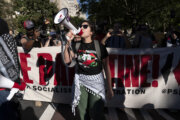Rate hikes prompt portfolio assessment.
The Federal Reserve raised rates eight times since 2015, three time this year alone — and many observers expect another hike before 2018 is over. Last week, 10-year Treasury yields hit new highs, briefly climbing to 3.2 percent and the highest levels since mid-2011. Since many market watchers expect rates to continue to rise, investors may want to rethink some of their holdings that are more sensitive to interest rate increases. Here are eight fixed income and equity exchange-traded funds to consider in a rising-rate environment.
SPDR Bloomberg Barclays 1-3 Month T-Bill ETF (ticker: BIL)
Chun Wang, senior analyst at the Leuthold Group, says investors in the fixed-income space should be cautious in the current rate environment. With rates up versus a year ago, that’s being reflected even in the very short-end of the curve giving investors safety with a little bit of a return. For short-term needs, Wang says Leuthold is using BIL, which invests in ultra-short-term Treasury bills with maturities of three months or less. Year-to-date its total return is 1.3 percent. It has an expense ratio of 14 basis points and has $5.2 billion in assets under management.
JPMorgan Ultra-Short Income ETF (JPST)
Joe Mallen, chief investment officer at Helios Quantitative Research, selects the actively managed ETF JPST for an ultra-short-term bond. It invests in a variety of debt with less than one year in maturity, including fixed, variable and floating rate debt from corporations and the U.S. government. He likes the “management team and the pedigree of the organization” and says fees are low. Year-to-date its total return is 1.9 percent. It has an expense ratio of 18 basis points and has $3.4 billion in AUM.
iShares Floating Rate Bond ETF (FLOT)
Given where the Fed is in the interest-rate tightening cycle, Wang says Leuthold recommends going defensive on the credit side, which is vulnerable in a higher-rate environment. Seek out higher-quality investments and don’t reach for yield with riskier assets. For slightly higher return with less risk they use FLOT, which tracks an index of investment-grade floating rate corporate bonds with maturities of zero to five years for slightly higher yields over Treasurys. Year-to-date its total return is 2 percent. It has an expense ratio of 20 basis points and has $11.7 billion in AUM.
ProShares UltraShort 20+ Year Treasury (TBT)
With interest rates going up across the yield curve, including in the longer-dated 20-year and 30-year bonds, Jay Batcha, founder and chief investment officer of Optimal Capital, says that indicates the Fed will continue to tighten monetary policy. He recommends a small position in TBT, which provides twice the inverse exposure to an index tracking the performance of U.S. Treasury securities with maturities greater than 20 years. Year-to-date its total return is 21 percent. It has an expense ratio of 89 basis points and has $1.7 billion in AUM.
VelocityShares Long LIBOR ETN (ULBR)
Investors who believe that interest rates will still rise this year and into 2019 could use a focus on short-term rate investments, which are most affected by Fed moves. For that, Batcha likes the exchange-traded note ULBR for a small position. It follows the daily change in the forward three-month London Interbank Overnight Rates, known as Libor. “When the Libor rate rises, the ETF goes up in lockstep,” Batcha says. Investors should keep in mind ETNs are an unsecured debt-instrument. The fund has an expense ratio of 1.5 percent and $16 million in AUM. Year-to-date its total return is 34 percent.
JPMorgan Global Bond Opportunities ETF (JPGB)
JPGB is an actively managed broad-based, broad maturity bond fund investing in both developed and emerging markets. Forty percent of JPGB’s assets will be invested in non-U.S. countries, with at least 50 percent of the assets U.S. dollar-denominated. Mallen says it’s a multisector play. “We think it’s one of the very few ETFs that has wider mandate in terms of go anywhere,” he says. Year-to-date its total return is down 1 percent. It has an expense ratio of 55 basis points and has $174 million in AUM.
Schwab U.S. Large-Cap Growth ETF (SCHG)
When rates rise in a strong economy, equity sectors and styles that usually do well tend to be more pro-cyclical growth oriented, says Todd Rosenbluth, senior director of ETF and mutual fund research for CFRA. For exposure to cyclical growth stocks, he likes SCHG, which has high exposure to economically sensitive sectors like technology, consumer discretionary and industrials. It’s also very cheap, with an expense ratio of 4 basis points. Year-to-date its total return is 6.8 percent. It has $6 billion in AUM.
WisdomTree US Quality Dividend Growth Fund (DGRW)
With rates rising, most people shy away from dividend-paying equities, however, Rosenbluth says DGRW has an interesting twist on the dividend-paying equity idea. The fund holds dividend payers with strong growth characteristics. “That means they’re likely to further increase their income payments,” Rosenbluth says. When selecting companies, the fund considers a company’s forward-looking earnings estimates with historical return-on-assets and return-on-equity growth. Year-to-date its total return is 1.8 percent. It has an expense ratio of 28 basis points and has $2.3 billion in AUM.
More from U.S. News
10 Reasons Warren Buffett Is a Better Investor Than You
7 Founder-CEOs Doing Fabulously for Shareholders
9 Tips to Conquer FIRE: Financial Independence, Retire Early
8 Ways to Invest as Rates Rise originally appeared on usnews.com







